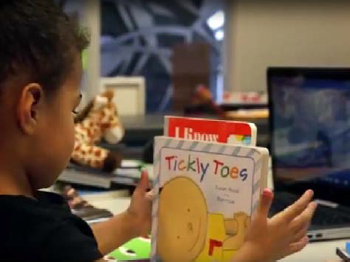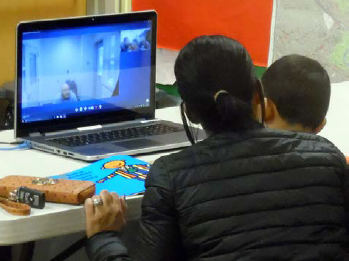Expanding Opportunities for Incarcerated Parents and Their Families at the Free Library of Philadelphia
Autumn McClintock is the Strategy Coordinator at the Free Library of Philadelphia.
 In 2013, when Titus Moolathara, librarian at the Free Library of Philadelphia, approached the Philadelphia Department of Prisons (PDP), there were no libraries in any of its six city facilities. Noticing this lack of access to information, and building on his prior experience as a library assistant at a state correctional facility, Titus sought to make a change: He wanted those in the prisons to have access to books. More than three years later, the Free Library enjoys a strong relationship with the PDP, which now has libraries in half its city facilities (with more on the way). Additional staff has also been hired to expand the initiative, and an innovative approach to family literacy—the Stories Alive program—is thriving.
In 2013, when Titus Moolathara, librarian at the Free Library of Philadelphia, approached the Philadelphia Department of Prisons (PDP), there were no libraries in any of its six city facilities. Noticing this lack of access to information, and building on his prior experience as a library assistant at a state correctional facility, Titus sought to make a change: He wanted those in the prisons to have access to books. More than three years later, the Free Library enjoys a strong relationship with the PDP, which now has libraries in half its city facilities (with more on the way). Additional staff has also been hired to expand the initiative, and an innovative approach to family literacy—the Stories Alive program—is thriving.
Stories Alive is a live, Skype-style storytime between inmates in the PDP and their children and family members who gather in our neighborhood libraries. The idea, launched in early 2016 with the support of an IMLS Sparks! Ignition Grant, is to give families opportunities to spend time together beyond the traditional walls of the prison visiting rooms, while they participate in literacy activities and build reading skills. The program is offered at both the men’s and women’s PDP facilities. During a Stories Alive session, families do a variety of things: they visit, share the latest about their lives, pray, and importantly, read together. Often, younger sons and daughters follow along and listen, while older children like to take the lead, showing off their reading skills to their parents. While this program has been a positive advancement for the Free Library and the families involved, getting it together was not without its bumps, and we still have a huge hill to climb to make a city-wide impact.
The number of adults in Philadelphia— the 5th largest city in the U.S—who are estimated to read at a 5th-grade level or lower is 550,009 [source: philaliteracy.org]. That’s a full one-third of the total population of the city. This crisis is a result of, among many factors, systemic poverty, a grossly underfunded public school district, and a dearth of resources for adult basic education. The Free Library’s mission is, in part, to “advance literacy and guide learning”—so we are continually seeking new ways to combat the low literacy problem, including seeking the expertise of other public libraries.
In an effort to collaborate with our peers, share what we learned in building the prison services program, and start a conversation among our peers, we created a toolkit: Expanding Opportunities for Incarcerated Parents and Their Families. The toolkit shares how we first established a relationship with PDP and then takes readers step-by-step through the process of enacting Stories Alive. It outlines the experience we’ve had thus far, and we intend it to be a guide for other libraries to use to explore programs of their own. We’ve been very pleased with program participants’ feedback, which has been overwhelmingly positive. Through post-session surveys administered by our staff, parents indicated that their child most often felt happy, excited, and playful while participating, and fewer than 8% indicated that their children were bored, sad, or worried. 97% indicated they would definitely participate again, and no one has indicated that they would not.
 We have been excited about these results, but we’ve also encountered our share of struggles. Working with a correctional institution is rewarding but challenging. For obvious reasons, its staff must follow strict, often bureaucratic, procedures in all they do, which meant a very methodical roll out of the program. One major hurdle was figuring out how to get the live, face-to-face connection from the prisons to the libraries, since inmates are not permitted to use traditional internet browsers. We finally devised a system of connecting through an interface at the PDP that it’s also uses to communicate with the courts. We hit another hurdle when we printed hundreds of community guides to give to inmates who were being released, only to find out that because the binding was metal, it wasn’t allowed inside the prison walls. Oops! (Don’t worry, we put them to good use in our neighborhood libraries!) Another significant challenge has been the barriers that families face in trying to participate in a program like Stories Alive. Though it has not been difficult to identify people who want to participate, we’ve sometimes had to cancel sessions because of families’ unstable schedules, or a lack of funds prohibited them from traveling to and from the library.
We have been excited about these results, but we’ve also encountered our share of struggles. Working with a correctional institution is rewarding but challenging. For obvious reasons, its staff must follow strict, often bureaucratic, procedures in all they do, which meant a very methodical roll out of the program. One major hurdle was figuring out how to get the live, face-to-face connection from the prisons to the libraries, since inmates are not permitted to use traditional internet browsers. We finally devised a system of connecting through an interface at the PDP that it’s also uses to communicate with the courts. We hit another hurdle when we printed hundreds of community guides to give to inmates who were being released, only to find out that because the binding was metal, it wasn’t allowed inside the prison walls. Oops! (Don’t worry, we put them to good use in our neighborhood libraries!) Another significant challenge has been the barriers that families face in trying to participate in a program like Stories Alive. Though it has not been difficult to identify people who want to participate, we’ve sometimes had to cancel sessions because of families’ unstable schedules, or a lack of funds prohibited them from traveling to and from the library.
Despite these challenges, we are very enthusiastic about the program, and staff has expressed a deep sense of satisfaction from being able to help forge stronger family relationships and build literacy-enriched activities for this population. We were especially encouraged by some of the feedback we have gotten. One family member said, “It was really nice … to be in a library setting reading stories. It was an all around good experience.” A participant from the prison said, “Had a nice time reading books to my baby. I will tell everybody about this service.” The Free Library is excited about the potential to grow Stories Alive and its other services to the incarcerated. We’ve had exploratory conversations about expanding the program at the state and federal levels, and we look forward to investigating those options.
Though each library will have to follow its own path in building a partnership and program like the Free Library’s, our hope is that the toolkit will act as a catalyst for broadening the conversation about services for the incarcerated, returning citizens, and their families, including helping us think of additional ways to serve these populations. If your library is thinking about a program like this or has one with a different approach, or if you use the toolkit in some way, we’d love to hear from you. We’re convinced that reaching out to those experiencing incarceration (whether that’s personally or via a family member) with rich, impactful services can move the needle on advancing literacy in our community—and yours.
